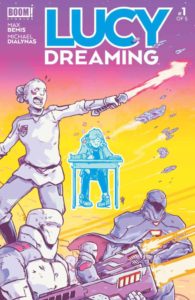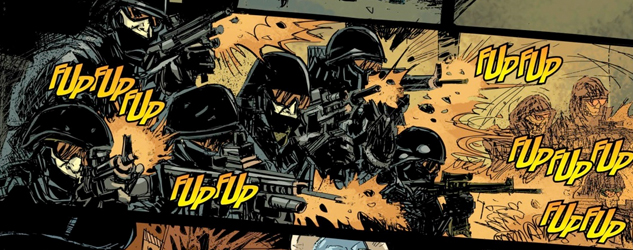 Lucy Dreaming #1
Lucy Dreaming #1
Publisher: Boom! Studios
Story: Max Bemis
Pencils: Michael Dialynis
Inks: Michael Dialynis
Colors: Michael Dialynis
Letters: Colin Bell
The urge to have a sense of belonging intersects in an ironic way with the urge to stand-out and be unique during the early teenage years, and it’s this awkward period of growing up that Max Bemis focuses on in this new title, Lucy Dreaming, a 5-part monthly series. On the first page, the title character Lucy is introduced, and her personality comes across immediately. This is a girl confident in her choices, reading out loud a gory passage from a teen/tween romance-horror-thriller novel to her parents while at the breakfast table.
Lucy’s confidence and offbeat quirkiness is further developed via peeks into writings from her “fake blog” (her diary, but she mentions that she’s too pretentious to call it that). Lucy quickly dissects her classmates into different social groups, and has a very real, honest conversation with herself about her anger that she can’t stop “feeling feelings” and how she wishes she could “plunge into the conformity” that she pretends to despise. These are the types of thoughts that many teenagers have, although most would be hard-pressed to find Lucy’s eloquent turns-of-phrase to describe them. Lucy is part of that new generation of teens, typically found in programs on the CW network, who express thoughts through an articulate use of language that most adults would find difficult even under the best of circumstances. As difficult as it may be to believe that a 13 year-old could write and speak with such ease, without a single “like” to be found, the thoughts being expressed come across as real, and help define Lucy as a deep, introspective, and somewhat confused kid. In other words, a typical teenager.
Things change, however, a few pages into this first issue of Lucy’s story. As described in the advertising copy for the issue on Boom!’s website, “In her dreams, Lucy is the hero of all her favorite stories, living each night as a grand adventure.” It’s here that the story takes a turn, but it’s for the better, as the dream world Lucy discovers allows Bemis and Dialynis to incorporate a healthy dose of humor and poke fun at “Star Wars” and other space-fantasy tropes in a tongue-in-cheek manner. Lucy, upon seeing her eyes turn a strange yellow color while looking in the mirror at night as she brushes her teeth to prepare for bed, assumes that this unexpected change is yet another in a series of unwelcomed pubescent changes her body is going through. She is not frightened, but rather perturbed that she wasn’t warned about this particular one. However, the change of eye color seems to trigger a much bigger change, as Lucy awakens in a completely different world where she is thrust, in media res, into a space battle with two companions who urge her to shake out of her daze and begin fighting back just like the warrior princess that she is. Lucy believes she’s in a dream, although she wonders why she’s not able to wake herself up like she normally does once she realizes that she’s dreaming.
It’s in the dream world sequences that Lucy Dreaming really shines. Dialynis’ exaggerated cartoon-like art style bring the world to life in a fun and unique way, combined with a change of palettes to focus more on darker colors. The space battle is much more brutal than might be anticipated from the art style, and that’s part of the fun. One does not expect to see armored space soldiers being blasted apart and horrible, graphic wounds dripping with alien blood, and characters vomiting from the pain of their injuries. Bemis has a lot of fun in these scenes, having one soldier soliloquize about his wounds, discussing the intense pain he feels, and then announcing, “I’ll never see my children again!” as he dies. Lucy reacts to this death scene by noting how realistic and disturbing it is, while just a few panels before she was blasting away with her space gun, accompanied by “Pew! Pew!” sound effects. The overall effect, with the horrors of war juxtaposed with Dialynis’ cartoon style and Bemis’ over-the-top descriptions and dialogue, make Lucy Dreaming something very different from most other “magical girl discovers her powers as a teenager” stories that has become prevalent in current pop culture.
There is much more to this, though, than just an absurd and graphic space battle. Lucy’s character actually changes once she accepts that she’s really living this and not dreaming. She reacts more like a typical teenager than the more eloquent and moody character from the “real world.” Then Bemis turns everything completely on its head with a conclusion to this first issue that is completely unexpected. From the introduction of what appears to be the “main villain,” to a different perspective on the Jedi Order from Star Wars, to Lucy’s return from the dream world and the repercussions thereof – none of these scenes play out as expected, but they flow naturally from the development of the story so it doesn’t come across as just doing things differently for shock-value.
Lucy Dreaming #1 is a very strong introduction to this new world and its characters, via fun and entertaining art, a compelling main character, and a very innovative story and world. The cliff-hanger ending makes the possibilities for the next issue extremely intriguing.
Martin Thomas
martin@comicattack.net


